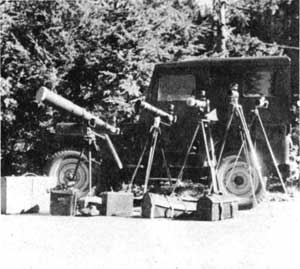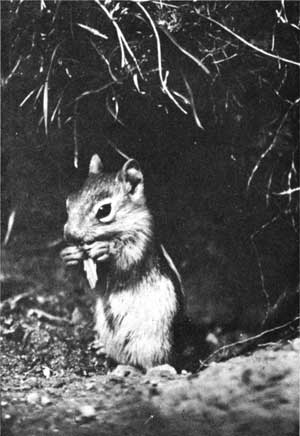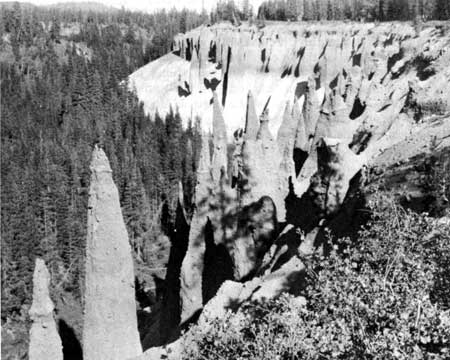A New Record in the Park for the Oregon Red Salamander
One of the rarest animals in Crater Lake National Park is the Oregon red salamander. Lawrence Bisbee, foreman of the fire guards, found the first specimen to be collected in the Park on August 7, 1951, under a pile of boards near the Annie Spring Campground. Intensive search in suitable habitats throughout the Park failed to reveal other specimens until July 5, 1952. On that evening six additional specimens of this salamander were found by a group of individuals under rocks and in rotten wood at the edge of Vidae Falls. The Oregon red salamanders that have been found in the Park are intergrades between two subspecies as is indicated by the scientific name, Ensatina eschscholtzil oregonensis x platensis. It is particularly interesting to note that the Vidae Falls collection establishes a new altitude record for this genus of salamanders – about 6700 feet in the Hudsonian life zone.
The Use of the Wheeler Creek Pinnacles by Nesting Birds
The Pinnacles of Sand Creek and Wheeler Creek have long been of interest to geologists because of their contribution to our knowledge of the pumice-scoria flows which descended the southern slope of Mount Mazama prior to its collapse. These Pinnacles are the results of the most intense fumarolic activity in the Park (Williams, 1942:8990). In this activity pumice and scoria were hardened in vertical columns by ascending gasses. The present form of the Pinnacles is the result of the modification of these original columns by wind and water erosion. Some of the Pinnacles are actually hollow and are sometimes referred to as “fossil gas vents.”
Curiously little attention has been given to the fact that the pinnacles are of some ornithologic interest. Frequently they are used by birds as song perches in the same manner as dead trees are used. Of even greater interest, however, is the use of small cavities in some of the Pinnacles as nesting cavities. There are at present records of the use of such cavities by three species of birds. On June 26, 1952, I saw a pair of Mountain Chickadees, Parus gambeli Ridgway, carrying material into one of these cavities. Although I was unable to be certain, it appeared that the material was items of food indicating that the eggs had already been hatched. On the same day Park Naturalist Harry C. Parker and I observed a pair of Mountain Bluebirds, Sialia currucoides Bechstein, entering repeatedly an opening in one of the Pinnacles. At the time, we could not feel certain that nesting activity was in progress. However, on July 29 I saw a female enter the same opening and on August 4, saw both male and female carrying insects into the cavity. In the vicinity were two juvenile bluebirds apparently completely independent of the adults. They were catching insects on the wing. It would appear quite possible that these juvenile birds were from the first brood with which the observations of June 26 could be associated, whereas the food-carrying observed on August 4, was doubtless in conjunction with the rearing of the second brood.
On July 19, 1952, I discovered a pair of Violet-green Swallows, Tachycineta thalassina(Swainson), carrying food into a cavity in the Wheeler Creek Pinnacles. The young could be seen and heard plainly. Although Violet-green Swallows have been observed (Farner, 1952:74) rather frequently in Wheeler Creek Canyon and elsewhere in the Park, this is actually the first breeding record.
It should be noted that both the bluebirds and chickadees normally nest in cavities in tree trunks. The Pinnacles thereby constitute a curious, although understandable, substitute for tree trunks.
It is further of interest to note that Rough-winged Swallows, Stelgidopteryx ruficollis(Vieillot), have also been known to breed in Wheeler Creek Canyon (Farner, 1952:75). However, it appears that holes in the cliffs, rather than holes in the Pinnacles, are used.
References
Farner, Donald S. 1952. The Birds of Crater Lake National Park. University of Kansas Press. ix + 190 pp.
Williams, Howell 1942. The Geology of Crater Lake National Park, Oregon. Carnegie Institution of Washington Publication 540. vi + 162 pp.
Nature Photography in Color in Crater Lake National Park
In nature photography it is axiomatic that you must take the picture when you see it, because it may not be there the next time you look. This implies the necessity of special equipment and a special willingness to go to work at any time, because wild life has a time clock of its own.

Photographic equipment used by Ranger-Naturalist Welles and Mrs. Welles during the summer of 1952.
I recall the particularly colorful yellow-bellied marmot that used to sit in the late afternoon on a rock in the meadow back of headquarters. We never saw him except in the late afternoon when the light was almost gone. I had watched for him there several times during the day but he never put in an appearance, so I finally realized that I would have to get him on his own terms and took his picture that evening about six o’clock. The next morning a marmot was found dead on the highway in the same vicinity, and while it may be merely coincidence, a particularly colorful marmot never appeared on that rock in the meadow again.
It is our belief that wild life should be photographed in the field as much as possible under natural conditions and natural light and natural habitat. In order to do this, Mrs. Welles and I carry with us most of the time a jeep-load of cameras, lenses, tripods, and miscellaneous equipment. This includes four Leicas, a Kodak Bantam, and lenses ranging in focal length from 35 mm to 640 mm. At all times we keep three Leicas mounted on telephoto lenses – a 300 mm, the 500 mm, and the 640 mm – with direct viewing repriscopes, each with its own special tripod. This leaves one Leica free for the interchangeable use of the 35 mm, the two 55 mm, the 85 mm and the 150 mm lenses for scenic, habitat shots and so forth. We employ flash guns, Strobe light and restrictive handling only when it appears impossible to get a picture any other way. For instance, a bat must be either held in the sunlight or taken with a flash because of his light shunning habits. Photographically speaking, the 1952 season at Crater Lake National Park was highlighted by the discovery and the subsequent coverage of a den of Cascade red foxes, a nest of bald eagles and the habitat of a great gray owl.
The red foxes were first reported to me on July 7th by Assistant Chief Ranger Packard, who went with me that afternoon to their den about half a mile beyond the Rim Village off the north road. After searching the area for about half an hour and finding no evidence of foxes, we decided we must be in the wrong location, and turned to go. As is so often the case, we found that although we had not seen it, we had been under observation by one of the young foxes for some time. He was sitting on the ridge about thirty feet away, apparently as curious about us as we were about him.

A very yound golden mantled ground squirrel taking what is perhaps his first bite of rotten wood. From a kodochrome by Ranger-Naturalist Ralph Welles and Florence Welles.


